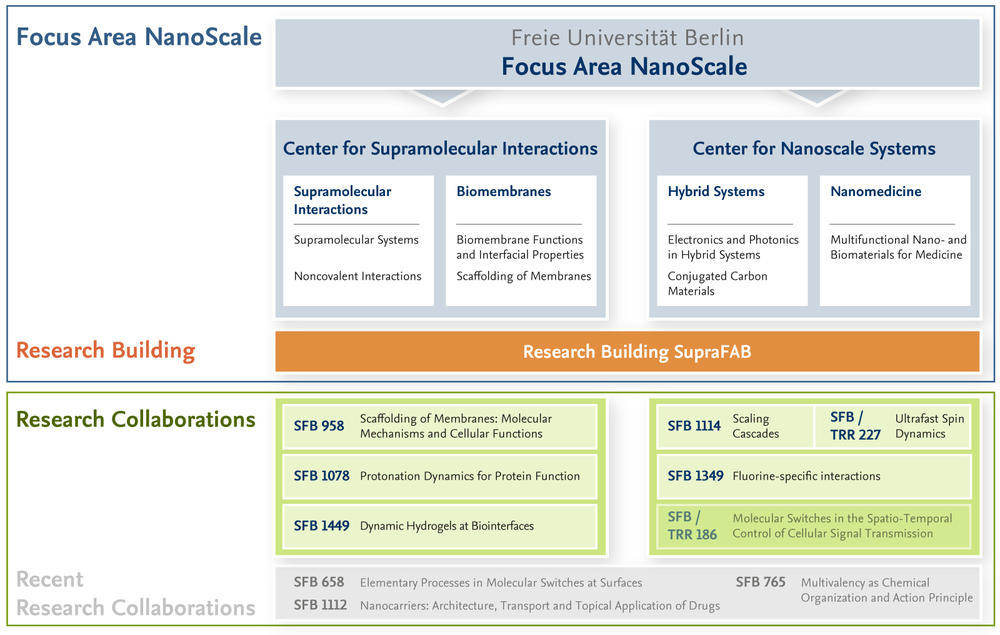Research
Research within the Focus Area NanoScale is organized in research areas which serve as nucleation points to initiate collaborations and initiatives for larger collaborative research centers.
Research Area "Biomembranes"
Research of the structure and interactions of biointerfaces like biomembranes is one of our main research foci.
Cellular membranes are liquid-liquid interfaces structuring cells. Integral membrane proteins of these membranes organize functional biomembrane units structuring and moving the membrane and transporting matter and information across membranes. We aim at the systems biology of biological membranes at the nanoscale with a resolution and complexity enabling generation and control of biomembrane functionality at will.
Biological liquid-liquid interfaces structure cells
Biomembranes structure the living world. Cell membranes consisting of lipids and membrane proteins separate a cell from its environment and permit subcellular compartimentalization, creating specific microenvironments. As liquid-liquid interfaces they carry the majoritiy of cellular targets of today's drugs. Integral Membrane proteins serve as central organizing elements, directing the formation of macromolecular assemblies, intricate nano-machines that scaffold the membrane and create functional units involved in processes like membrane stabilization and membrane transport, transport of molecules across membranes and signal transduction, the exchange of information between the cell and its environment. Their functionality governed by their interfacial properties is still subject to intense research.
Aiming at the systems biology of biological membranes
We envision a systemic description of structure and function of biological membranes. This requires advanced optical and spectroscopic methods that permit highest spatial and temporal resolution. Such nanoscopic techniques will be developed and adjusted to the requirements of the experimentla approaches.Theoretical approaches matching nanosystems at all levels of complexity will complete our holistic approach to biomembrane functionality at the nanoscale.
Generating and controling biomembrane functionality at will
Ultimately, the generation of functional biomembrane units, of nano-structured biomimetic interfaces and the control of molecular functions by external fields will be feasible.
An excellent example for the expected level of understanding and control demonstrates the emerging field of optogenetics, as exemplified by channelrhodopsins. These integral membrane proteins function as light-induced ion channels. Combining tissue-specific expression and engineered channelrhodopsi-variants, for example, may allow to specifically induce calcium influx into distinct cells in selected tissues by illuminatio, which renders calcium-based signalling processes accessible to regulation at will.
Research Area "Supramolecular Interactions"
Macromolecules and multi-molecular ensembles are formed and stabilized by noncovalent forces. Such weak interactions allow to generate stable supramolecular structures. Research in this area focusses on functions of such structures and their molecular interactions. Novel structures with their particular new properties promise developing innovative concepts and applications
Research Area "Hybrid Systems"
Hybrid systems innovatively combine various molecules into nanomaterials. The interactions and functional properties of such molecular combinations are being explored. In unraveling their material properties, exciting physical effects are being explored adn characterized that may allow for example production of miniaturized electronic circuits or of customized surfaces. Of particular interest are molecules that act as molecular switches when excited eletronically, magnetically or photonically (i.e. by light).
Research Area "Nanomedicine"
Nano-structured biocompatible materials hold the promise for novel medical tools (diagnostic agents, medical devices, drugs). According to physiological and medical requirements, chemists synthesize tailor-made molecules, which will show improved detectability, hit their targets better and will have reduced risk of unwanted side effects. The vision of the stream-lined development of nanomedicals will be addressed by a highly integrated collaborative research concept involving chemists, bioscientists, pharmaceutical scientists and physicians.
